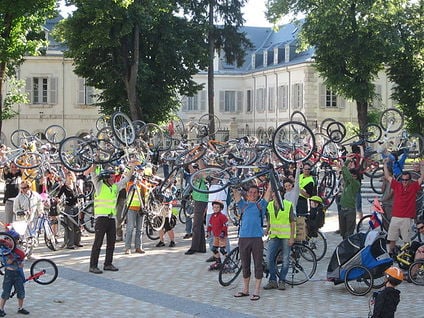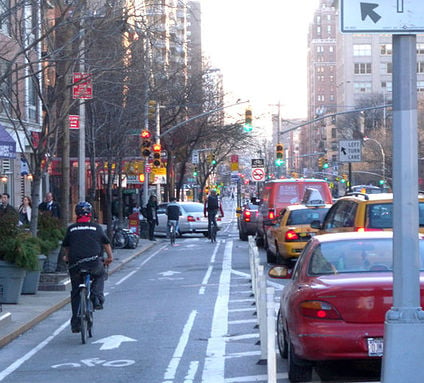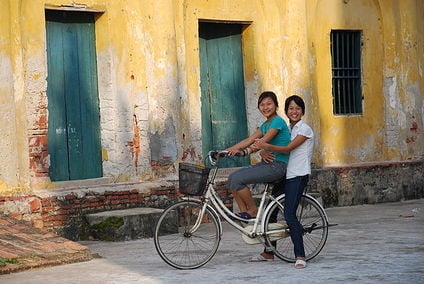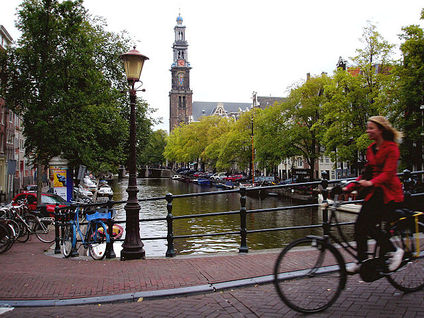m (→Resources: adding template) |
m (redesign) |
||
| Line 1: | Line 1: | ||
{{Cyclingnews}} | {{Cyclingnews}}[[File:Vélo parade - Vélorution - bike critical mass.JPG|424px]]<br clear=left> | ||
== What communities can do == | == What communities can do == | ||
{{topico}} | {{topico}} | ||
Revision as of 17:41, 4 October 2015
What communities can do
- advocate and support bike-sharing schemes
- advocate development of cycle lanes and adequate places for cyclists to lock their bikes
- develop Cycle maps
- encourage 'Cycle to Work' schemes
- encourage use of electric bicycles, see for example Devon#Cycling
- organise Cycle days or events such as Dr Bike days
- promote Bicycle trailers, etc. eg to help with growing and gardening
- promote bikesurfing
- promote Quiet Lanes
- run community bicycle workshops, see for example Tumeke Cycle Space in Auckland
- think creatively about pedal power eg Bike snow plow
Why cycling matters
Environmental issues
The bicycle is the most energy efficient means of land transportation known to man.
A person cycling pollutes very little. This even holds true in a life-cycle perspective, where the production and disposal of the bike is included, when comparing to those going by car or even by bus.
The life-cycle pollution and total financial costs of a private car is much higher than what is generally acknowledged.
Similarly the total costs to society of bloated use of the private car is vastly underestimated.
A cyclist often inhales air that is less polluted than a car driver, because of the position of the air intake, and the slow ventilation in a car. Larger volumes of air inhaled might compensate this to a certain extent, but cyclist have better health, so it appears to generally take more before pollution effects cyclists adversely. Besides, if local air pollution from cars is a problem, then more cycling and reduced car traffic would be part of the solution, leading to less pollution, rather than the opposite. Any restrictions on cars, and provisioning for cyclist access would consitutes a strengthening of the polluter pays principle (ref: Cycling the way ahead...)
Increased cycling is a splendid and easy way to increase biofuel shares of total fuels consumption, and increase energy efficiency
Health
Cyclists live longer than non-cyclists (Lars Bo Andersen, 2000, Archives of Internal Medicine)
See the point about traffic fumes above.
The obesity and sedentary epidemic is poised to be one of the top health problems of the OECD-countries, passing cigarette smoking in the number of people killed yearly. Some official estimates from the U.S. puts the estimated number of deaths due to bad diet and lack of exercise combined at 300 000 a year, wich means 0,1 % of the population. This vastly exceeds the number of people killed in traffic yearly, which is more than 40 000 persons yearly, in the USA
To fight the ill health effects of increasingly sedentary ( still-sitting) lifestyles, the WHO recommends that every adult do light exercise for a total of 30 minutes each day. Moderate exercise is preferrable to vigourous exercise as the effect for health is comparable and the risk of injuries less. Exercise that is part of the daily routine is preferrable, as it is more likely to be sustained. All in all cycling or walking all or part of the way to work, school or other regular errands, is a perfect match to those recommendations.
Most will find cycling for daily errands much cheaper than paying for going to the gym or a swimmingpool.
Cycling is kinder to the knee joints than jogging, and is believed by some experts to give superior cardiovascular exercise.
Practicality and government support
It is possible : Cities like Oulu (northern Finland), Trondheim (Norway), Copenhagen (Denmark), Groningen and Amsterdam (The Netherlands) and Beijing (China) all have cycling levels exceeding 10% modal share. All except Trondheim exceed 25% modal share. Groningen and some Chinese cities have passed 50%. After congestion charging was introduced in London (UK), cycling has increased substantially. As oil prices rise, and people concerns about health mount, cycling is on the rise in many western societies
Many European governments actively promote cycling and so does the World Health Organisation and WorldWatch Institute and many more. The Environmental directorate of the EU published the booklet "Cycling: the way ahead for towns and cities" in 1999. Increased cycling reduces congestion. In some cities with moderate levels of cycling ( say 5-8%), it is estimated that congestion would worsen severely if all cycle trips would be replaced by car-trips. If public transport is at or near full capacity, the same holds true there.
Increased cycling is generally very beneficial to traffic safety. Experienced, adult cyclists are ofen as safe or safer even on an idividual level than in a car, according to "Cycling the way ahead for towns and cities"
The bike is often fast and predictable in settings where congestions is rampant and distances short. (Going by car is ofen slower in many European cities than cycling, that is near city centre and congested areas)
Again : Most will find cycling for daily errands much cheaper that paying for going to the gym or a swimmingpool. As the two activities of transport and exercise are combined, ofen time is saved. If many instances money is saved by paying less for public transport, buying less petrol, perhahps a lower insurance and mortages on (the) car(s). The money thus saved can sometimes be compared to or even converted to the time taken to earn that money
See also: Benefits of cycling
The social climate
Increased levels of cycling are coducive to equity : Both gender and income-equity.
Improves the local psychological atmospehere when replacing car-trips
It has been claimed that programmes to reduce car dependence, and improve conditions for pedestrians and cyclists, can reduce crime, as exemplified by the experience from Bogota, Colombia (Reforms carried out by mayor Enrique Penalosa, and his predecessor)
Cyclists are accessible for communicating with. They are not boxed in, stuck in traffic or dashing past, so one can ask directions etc. The proportion of humans to metal boxes in the environment of citizens increases, and most people will perceive the town, city or village to be more alive and agreeable
Cycling cities
The Copenhagenize Index 2013 of bicycle friendly cities.
Resources
- How to Start a Bike Kitchen, November 2014 Shareable
the Copenhagen Wheel
Citizens data initiative
There are now over 100 million electric bicycles in China -- the most popular (by far) "green" vehicles in the world. [1]
Maps
Initiatives, Worldwide Cycling Atlas
Video
more video: Cycling Friendly Cities, 2007
See also
- local information can be found, or shared, via our many location pages
- Cycling, category:Cycling
- Road safety
- Sustainable transport
- Sustainable transport activism
Interwiki links
Wikipedia: Utility cycling, Bicycle culture, Bicycle sharing system, Critical Mass (cycling), Cycling advocacy, World Bicycle Relief
External links
- World Bike Forum, yearly cycling activism event in which the topics of bicycle urban mobility and the planning of cities made by and for the people are discussed. W
- Worldwide Cycling Atlas
References
Template:Attrib sca ref



